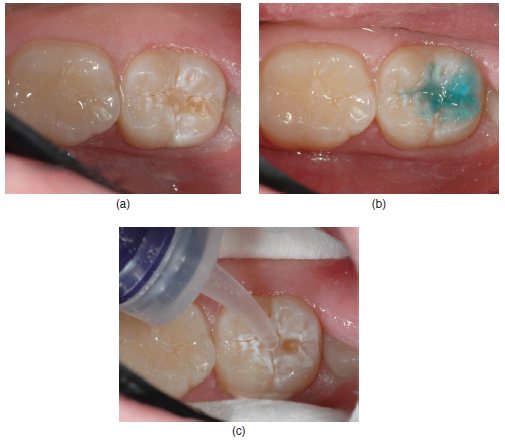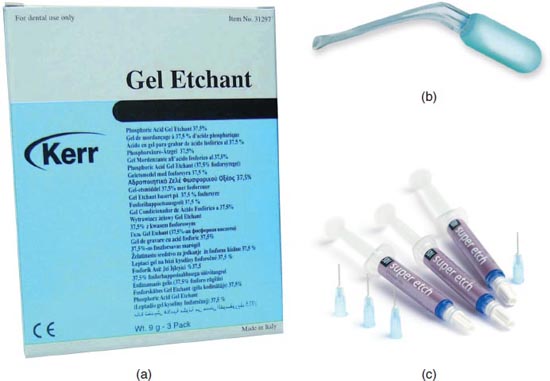Chapter 6
Acid etchant, bonding agents and fissure sealants
ACID ETCHANT
Definition
Acid etchant (more commonly known as acid etch) is available in a phosphoric acid solution or gel and is commonly available in 15%, 34% or 37% concentrations (37% being the most common). Acid etch creates microscopic spaces in enamel (increasing surface roughness) into which the bonding agent/adhesive can flow, aiding the bonding process (micromechanical retention). When desiccated, a surface that has been etched appears chalky white or frosted (Figure 6.1c). Acid etch also removes contaminants from the surface, aiding in the wettability of the enamel. (It removes the smear layer and acquired pellicle.)
An acid is used to remove some of the mineral elements in the tooth to promote adhesion. When placing a restoration into a cavity preparation (Figure 6.1a), it is usually desirable or essential (when working with certain materials) to use an acid etch (Figure 6.1b) and resin adhesive to adhere/bond the restoration to the tooth structure (enamel or dentine).
Figure 6.1 (a) Prepared tooth surface prior to acid etchant placement. (b) Acid etchant placement. (c) Chalky white/frosted appearance of acid etchant (photos courtesy of Dr. Mitsuru).

Material constituents/composition
- Phosphoric acid solution Available in:
- liquid solution (rarely used)
- gel (tends to be easier to use as it does not run)
- syringes or bottles
Properties
- Moisture sensitive
- Best practice is to use a rubber dam when using acid etch
- Prior to use, the surface must be clean (use pumice and brush – do not use prophylaxis paste as the fluoride and other constituents may leave residue and interfere with bonding properties)
Advantages
- Creates a surface roughness of enamel that aids in increasing the wettability of enamel, which allows for the micromechanical bond between the restorative material and enamel
Disadvantages
- Care must be taken to protect eyes, skin and intra-oral soft tissues when using acid etch due to its acidic properties. The dental team should always wear appropriate personal protective equipment, as well as ensuring the patient wears protective eye wear
- Technique sensitive
Indications and contraindications for use
Indications
- In areas where a micromechanical bond is desired, such as sealant placement, resin composite restorations, directly bonded orthodontic brackets, veneers and resin-bonded crowns and bridges
Contraindications
- May be difficult to use in children, patients with special needs and the elderly as it may be hard to achieve good moisture control
- Should not be used in patients where excellent moisture control is not possible
- Should not be used during treatment of patients who cannot tolerate or facilitate time-consuming appointments
Trade names
| Trade name | Manufacturer |
| Gel Etchant (Figure 6.2a) | Kerr |
| Microdose Etch (Figure 6.2b) | Premier |
| Super Etch (Figure 6.2c) | SDI |
| Total Etch | Ivoclar |
Figure 6.2 (a) Gel etchant – Kerr. (b) Microdose etchant – Premier Dental. (c) Super etch – SDI.

Manipulation
See below – manipulation for acid etch and bonding agents are combined as they are often used in conjunction with each other.
Mixing time
- There is no mixing with acid etch – it comes ready for use
DENTINE PRIMER AND BONDING AGENT
Dentine primer or dentinal conditioner may be used at the operator’s discretion, following the manufacturer’s instructions, after acid etching. The purpose of adding a dental primer is to wet the dentine and penetrate into the dentinal tubules as enamel-bonding agents cannot penetrate dentine.
A bonding agent (also referred to as adhesive) is often used in conjunction with acid etch. It aids in the retention between the restorative material and the tooth; it also fills the microscopic space that is left between a restoration and the tooth structure. Filling this space is beneficial as it reduces the chance of microleakage around the restoration. The bonding agent may directly adhere to the enamel, or to the primer used with exposed dentine.
There are many bonding or adhesive systems on the market, which include all the materials that are normally needed during the bonding process.
Material constituents/composition
- Primer (dentine conditioner) – soaks into the enamel and dentine
- Seals dentine tubules
- Forms a hybrid layer
- Adhesive/bond – joins hybrid to composite
Properties
- Using a bonding agent in conjunction with acid etch can decrease temperature sensitivity experienced by the patient
- Dentine/enamel bonding systems classification: (van Meerbeek, 2003)
- Etch and rinse
 Etchant
Etchant Primer – primer is dissolved in various solutions (e.g. acetone, alcohol or water), which requires it to be directly applied to a single-use applicator brush (disposable)
Primer – primer is dissolved in various solutions (e.g. acetone, alcohol or water), which requires it to be directly applied to a single-use applicator brush (disposable) Adhesive/bond
Adhesive/bond Etchant
Etchant Primer/adhesive/bond – primer is dissolved in various solutions (e.g. acetone, alcohol or water), which requires it to be directly applied to a single-use applicator brush (disposable)
Primer/adhesive/bond – primer is dissolved in various solutions (e.g. acetone, alcohol or water), which requires it to be directly applied to a single-use applicator brush (disposable)- Self-etching – non-rinse
 Acidic primer
Acidic primer Adhesive/bond
Adhesive/bond Contains all
Contains allAdvantages
- Enables the usage of resin-based products by promoting adhesion to tooth structures
Disadvantages
- Dentine is hydrophilic (water loving) and bonding agents are hydrophobic (water hating)
Indications and contraindications for use
Indications
- Bonding agents are suitable for use with/>
Stay updated, free dental videos. Join our Telegram channel

VIDEdental - Online dental courses


